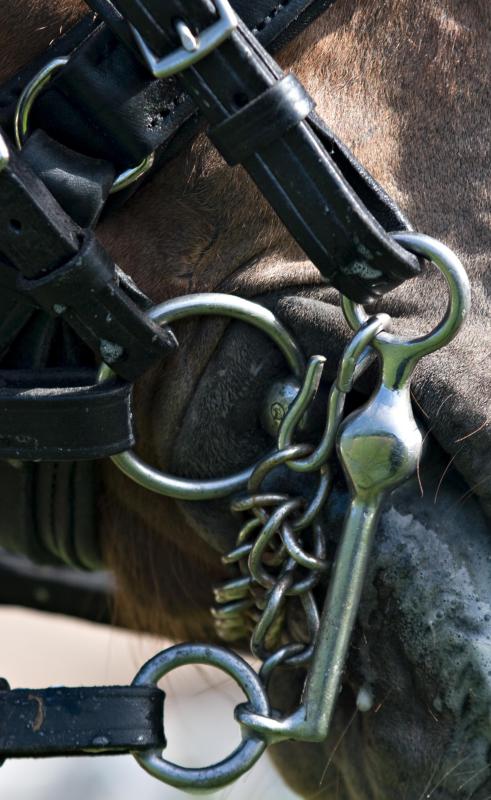At AllThingsNature, we're committed to delivering accurate, trustworthy information. Our expert-authored content is rigorously fact-checked and sourced from credible authorities. Discover how we uphold the highest standards in providing you with reliable knowledge.
What are the Different Types of Horse Training Equipment?
Horses are graceful and beautiful animals that have been domesticated for human use for thousands of years. Nevertheless, before a horse can be used for work, sport, or competition, it must undergo a vigorous education by human trainers. Specific horse training equipment will depend on what the horse is being trained to do, but there are many pieces of general horse training equipment that may be important to own and understand before beginning a horse's training.
Probably the most basic piece of horse training equipment is the halter. This is a detachable headpiece that wraps around the horse's nose and head. A halter is usually attached to a lead line, similar to a leash, that allows the trainer to direct the horse where to go and when to stop through gentle pulling and tugging. It is important to fit a halter correctly, as a too-loose fit can allow the horse to get out of it, while a too-tight fit may cause irritation to the skin.

Similar to a halter is a bridle, which is used to direct the horse while riding. Bridles are usually made of leather and consist of a halter-like structure for the horse's head, and a long pair of reins that are held by the rider. The reins are attached to the bit, which is a small mouth guard that fits into the horse's very sensitive mouth. Using the reins to apply gentle pressure to the bit lets the rider communicate to the horse a variety of commands.

Few sets of horse training equipment would be complete without a saddle. A saddle may be distinctly different depending on the type of training involved; English-style saddles are typically very small and flat, while Western-style saddles are much more bulky and ornate. Saddles are clipped or hooked together under the horse's belly, while many have stirrups that hang down on either side for the rider's feet. Saddles may need careful adjusting to remain in the correct placement without being tight enough to cause chafing of the horse's skin. An improperly positioned saddle can also slide off, taking the rider along with it.

Some horse training equipment is for the safety of the rider. Beginners may be required to wear a helmet at all times, to prevent head injury in the event of being thrown from the horse. Many people wear protective gloves to prevent sweat from ruining their grip on the reins. Sturdy shoes or boots are useful, as horses can sometimes step on their rider's feet.
Some riding disciplines use horse training equipment such as spurs, whips, or crops. These pieces of equipment are meant to guide the horse through slightly uncomfortable sensations, such as the light tap of a crop. It is important to remember that these tools are never meant to be used to discipline or punish a horse.
Frequently Asked Questions
What is the purpose of using a saddle in horse training?
A saddle is fundamental in horse training as it distributes the rider's weight across the horse's back, making it more comfortable for the horse to carry a human. It also provides stability and support for the rider, enhancing communication between horse and human. Saddles must be properly fitted to avoid discomfort or injury to the horse.
How does a bridle contribute to horse training?
A bridle is a critical piece of equipment that includes a headstall, bit, and reins, allowing the rider to direct and control the horse. It plays a vital role in communication, as subtle cues and signals can be sent through the reins to the bit, influencing the horse's direction and pace. Proper use is essential for effective training and safety.
What are lunging equipment and its benefits in horse training?
Lunging equipment, such as a lunge line, lunge whip, and cavesson, is used to train horses in a circle around the handler. This practice develops balance, suppleness, and obedience while allowing the horse to work freely without the weight of a rider. It's an effective way to exercise and assess a horse's movement and behavior.
Can you explain the use of martingales and their types?
Martingales are used to prevent horses from raising their heads too high, which can lead to loss of control. There are two main types: the standing martingale, which attaches to the noseband and girth, and the running martingale, which connects to the reins through rings. Both types should be used with care to avoid restricting the horse's natural movement.
What role do horse boots and wraps play in training?
Horse boots and wraps protect the horse's legs from injury during training sessions. They provide support to the tendons and ligaments, absorb shocks, and prevent scrapes or bruises. Different types are designed for specific activities, such as jumping boots for shock absorption or dressage boots for protection during precise movements.
Why is it important to choose the right bit for horse training?
The bit is a crucial tool for communication between rider and horse. Choosing the right bit is important because it affects the horse's comfort and responsiveness. The wrong bit can cause pain or discomfort, leading to resistance or behavioral issues. Factors like the horse's mouth anatomy, training level, and discipline should guide the selection of an appropriate bit.
AS FEATURED ON:
AS FEATURED ON:













Discuss this Article
Post your comments